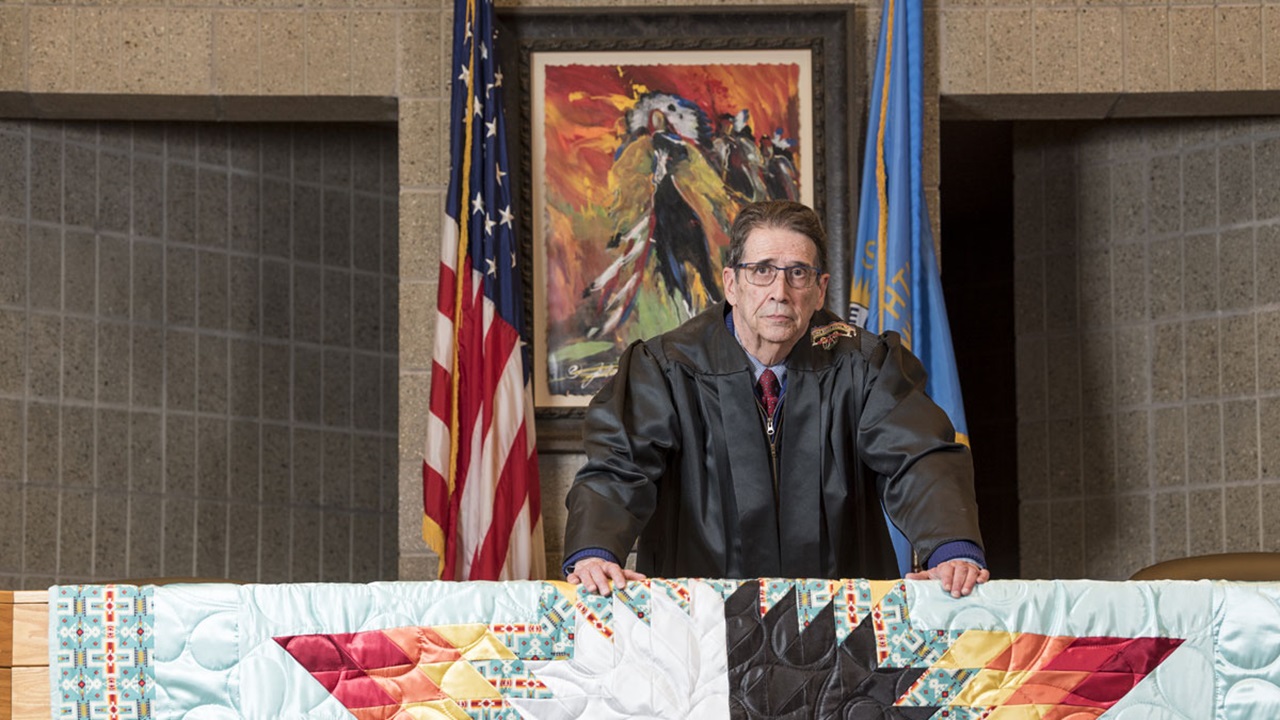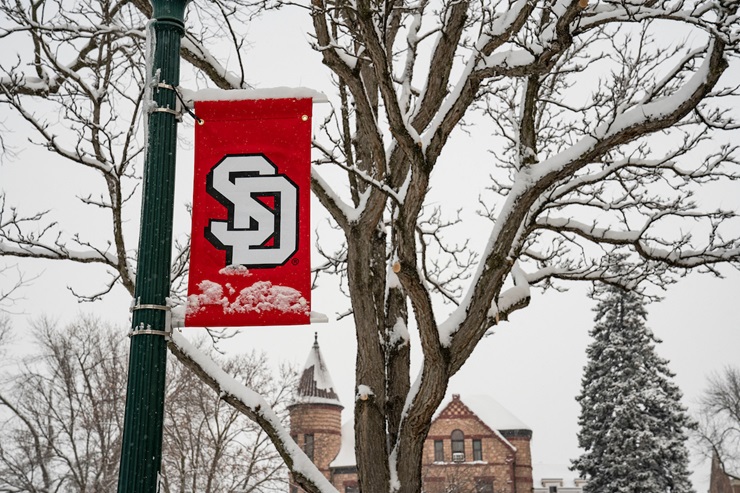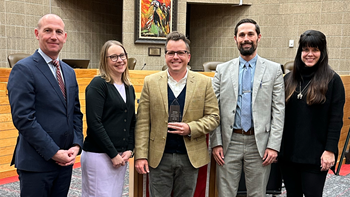Professor Frank Pommersheim Retires after 35 Years

Pommersheim, who grew up in Queens, New York and graduated from Columbia Law School, had an unlikely beginning in Indian law, first exposed to Indian country as a Volunteers in Service to America (VISTA) lawyer in rural Alaska after law school.
“I had never been west of the Mississippi River but I was very taken by the cultural element and spirit of generosity,” Pommersheim said.
After his program ended, he briefly returned to New York before accepting a position in 1973 at a college that was just forming on the Rosebud Indian Reservation, Sinte Gleska University.
“I thought I would be there for a short stay, but ended up spending 10 years living in Rosebud,” he said. “Sinte had a philosophy at that time of decentralized learning. They didn’t have a campus then so you took your classes to the community.”
While at Sinte Gleska, Pommersheim was encouraged to become an active member of the community. He said sports were a leveler.
“I played softball and basketball and went to powwows and events,” he said. “I’m not sure if others would agree, but I would describe myself as fairly shy so to a certain extent, it was good for me.”
After 10 years living in Rosebud, including three directing Dakota Plains Legal Services, which provides legal aid to Native Americans across South Dakota, Pommersheim was recruited to join the faculty of the USD law school in 1984 primarily to teach Indian law.
“Frank had lived on the Rosebud Sioux Reservation for a decade before becoming a law school professor, and he brought his friendships, insights and love of Native culture with him to the law school,” said Christine Hutton, who taught alternating sections of Criminal Law and Procedure with Pommersheim for decades.
As a professor, Pommersheim started two traditions that have lasted more than 30 years – a biennial Indian law symposium and a field trip to the Rosebud Indian Reservation.
“I think we’re the only law school in the country to have hosted an Indian law symposium for 30 years,” Pommersheim said. “It’s an opportunity for students and the community to hear about the issues. There are very few forums where Indians and non-Indian people can come together.”
Another way Pommersheim exposes students to Indian law is through an annual field trip to Rosebud.
“When I started teaching here in 1984, most of my students were from South Dakota. I assumed they knew something about Indian reservations,” Pommersheim said. “Two years in, I realized they didn’t. “People just kind of accept the landscape they’re in,” he said.
During the field trip, law students watch tribal court proceedings, visit the local jail and meet with various members of the community, culminating in a meal prepared by the court staff at the end of the trip.
“When I read student evaluations, they say the field trip is the greatest thing about the class. What it does without intentionally trying to do it is dismantle a lot of stereotypes,” Pommersheim said. “Yes, there is a lot of poverty on the reservation. Yes, there is a lot of alcoholism. But there are a lot of people trying to do good too,” he said. “You can talk about it in class, which is important to do, but having students go out there–it’s different. It’s become an essential part of the class.”
It is this unique style–reserved but insistent–that has made Pommersheim so successful at reaching those around him.
“He is a quiet soul that instigates in everyone he meets–be it a student, colleague or stranger–a goal to aim higher,” said Teresa Carlisle, registrar at USD Law School, who has worked with Pommersheim for more than 18 years. “Do not be the status quo. Push boundaries. Don’t back down.”
“It has been a privilege to be part of the last class to enjoy learning Criminal Law and Procedure from Professor Pommersheim,” said Connor Donohoe, a first-year law student. “His unique style creates a comfortable learning environment that will be missed.”
Pommersheim’s career stretched beyond his academic role at USD law School. Around the time he began to teach at USD, Pommersheim had also begun serving as a tribal judge in Rosebud and then for other tribes as well. Currently, he serves as a justice for the Santee Sioux, Crow Creek, Rosebud and Winnebago Tribes. In the past, he had been a justice for the Saginaw Chippewa, Lower Sioux, Mississippi Band of Choctaw Indians and the Grand Portage Chippewa. He has served as the chief justice of the Cheyenne River Appellate Court of Appeals for 31 years. In 2018, he was honored by the Cheyenne River Sioux Tribe with a star quilt for his commitment to Indian law.
“Somewhat unexpectedly, I found myself sitting on tribal courts and writing a lot of opinions. And that was significant to me for my own professional development. At that time, tribal courts became more popular, so it became an area of intense focus for me,” Pommersheim said.
He said after 30 years of experience with Indian law, respect is the key starting point to any discussion.
“I use the word respect. It’s huge in the Lakota world. The Lakota people have to feel like you respect them,” Pommersheim said.
He believes governments need to find more areas to cooperate to solve shared issues.
“I try to impress upon my students that good lawyering is oftentimes finding the zones where you can cooperate and people can get along. That’s an important legal skill to have,” he said.
Despite the challenges, Pommersheim is hopeful about the future.
“You can’t escape history but I think slowly but surely there is more good faith on both sides and more and more people on the tribal and state level know more about Indian law,” he said. “Indian law has become more important. We offer more than just a mandatory course. And South Dakota is the only state in the country where Indian law is a mandatory question on the bar exam. To me, that’s quite significant.”
This optimism and dedication have contributed to Pommersheim’s outsized influence on the field of Indian law–a fact his peers and colleagues recognize.
"It has been a privilege to be part of the last class to enjoy learning Criminal Law and Procedure from Professor Pommersheim. His unique style creates a comfortable learning environment that will be missed." - Connor Donohoe, a first-year law student
“He is, in the best sense of the word, not just a scholar, a thinker and an Indian law professor, but also a longtime advocate for the rights of Indian people over his 35-year career in the field of Indian law,” said Charles Abourezk, chief judge of the Oglala Sioux Tribal Court.
“He is the most esteemed scholar, teacher, judge and practitioner ever in the field,” said Matthew L. M. Fletcher, professor of law and director of the Indigenous Law and Policy Center at Michigan State University. “An entire academic career could be built on reading exclusively from [his] corpus of tribal law.”
“It is noteworthy that a recent tally of authors who cite Frank’s published articles is close to 1,000. Researchers have downloaded close to 10,000 of his works,” said Hutton. “That does not include the research and references to his books on Indian law. Frank’s impact on Indian law scholarship truly is incomparable.”
As for what Pommersheim thinks of his own role in the history of Indian law in South Dakota including his 2018 commendation by the Cheyenne River Sioux Tribe, he was reticent.
“When I first came to Indian country, I remember going to one of the first graduations and being amazed to witness and experience the generosity of a giveaway,” he said. “I was called forward to receive a star quilt by the family of one of the students. It was an incredibly powerful experience.
“It’s not an award. In the Lakota way, you don’t give awards. They honor you. I think there’s a lot in the honoring that goes unsaid. There’s a tribe, a town, a community that appreciates what you’ve done,” Pommersheim said.
“It’s hard to put into words, but words aren’t really needed. I felt it very deeply.”



